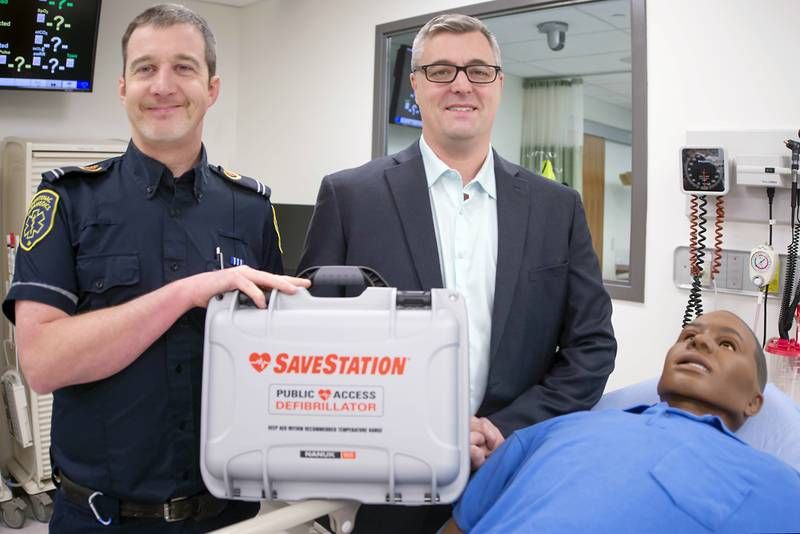Jeff Green | Mar 15, 2023
As an emergency room physician and researcher into cardiac arrest and resuscitation, Dr. Stephen Brooks of the Kingston Health Sciences Centre and Queen's, is well aware of a rather startling reality faced by patients when they suffer heart attacks.
“For every minute when a patient's heart is not beating, which is what a heart attack or cardiac arrest is, their chances of being resuscitated decrease by 10%,” he said.
Even the best responses to the highest priority calls, in urban centres like Kingston, take about 6 minutes, Dr. Brooks said, and in rural locations with lower population densities, the response is much slower than that because of distances.
In Frontenac County, as in other parts of the province, the local volunteer fire departments as well as paramedics are dispatched to medical emergency calls, and they are often the first to arrive and are trained in resuscitation and equipped with defibrillators.
“You need multiple layers of response,” said Dr. Brooks, “in order to shave minutes off the response time. That’s where Neighbours to Neighbours comes in.
Several years ago, he spent a year in Scotland, and while he was there, he studied the Neighbours to Neighbours program in Aberdeen and the surrounding region.
“There are a series of rural villages in the countryside near Aberdeen where this program was developed. What happens there is that at the same time as paramedics are dispatched in response to a cardiac arrest, a call also goes out to the neighbours who have been trained and equipped in resuscitation and live close to where the call is coming from. The idea is to bring that program to Ontario.”
With funding from Queen's, Brooks approached Frontenac Paramedic Services to operate a pilot project, focussing on rural Kingston (north of the 401) and Frontenac County. The Neighbours-to-Neighbours pilot project, which will be launched soon by Frontenac County, will start by seeking volunteers throughout the region to join the program.
“When a call comes in to the dispatch centre in Kingston, after contacting emergency services, and only if they have time, the dispatcher will then put out a notification on an app that will then notify the volunteers located closest to where the call is coming from,” he said.
The research project that Dr. Brooke is running as part of the pilot, is being designed to measure the time savings before the initial response to the 50-60 cardiac arrest calls that come in each year in Frontenac County.
“If we save 5 or 6 minutes from the average response time, that would have a big impact,” he said.
The project is being developed and will be operated by Frontenac Paramedic Services (FPS). Jason Kervin, who works in Community Paramedicine with FPS as an Education Coordinator, is co-ordinating the program.
He said that individuals who want to get involved will take part in an initial session, which can be done virtually, for about 3-4 hours, which will be followed by a live training session which will include the standard CPR certification along with other training.
“We are still designing the program, but we see the live session running about 5-6 hours,” he said. “There will be ongoing contact with participants every couple of months, which we think will have both live and online participation, and we expect those not to be long sessions. We don’t want to make joining the program too much of a burden for people.”
Thanks to a donation, 25 portable automatic defibrillators (AED’s) are available to get the program underway, and to start up the program they will be shared among volunteers who live near each other.
“If we have a cluster of volunteers in a place like Verona or Sharbot Lake, they will be able to trade off the AED among each other based on who is most available on certain days of the week,” he said. “Ideally we would like to have an AED with each volunteer, but that will take time.”
The program has been under development for over 2 years, with delays due to COVID and other factors.
Even though it is waiting for one final protocol to be worked out before it is officially launched, a website has been built and is up and running on the Engage Frontenac platform, under Frontenac County projects.
The site outlines how the program will work, and includes information about eligibility.
Adults over 21, who have a cell phone and access to a vehicle, are physically able to perform ‘moderately physical activity’ and are available for training are encouraged to fill in a simple online form.
Once the program has its official launch, a publicity campaign for Neighbours Saving Neighbours will get going.
“One thing we don’t know, and this is key to the success of Neighbors Saving Neighbours, is how many volunteers we attract after we launch,” said Kervin. “Not only do we need good numbers, we also hope to get some people in the less population parts of Frontenac County, in Central and North Frontenac.”
For further information, go to EngageFrontenac,ca, click on Frontenac County Project icon and click again on Neighbours Saving Neighbours.
The Neighbours to Neighbours program will be launched later this spring.
More Stories
- Latest CUPW Job Action Stops Postal Delivery Of The Frontenac News Forcing Alternate Plans
- Opponents of Barbers Lake Gravel Pit Pack Ag Hall in McDonalds Corners
- Bobsleigh Olympian Jay Dearborn At Mikes Pizza In Sydenham
- The Loins Club Of and O'Lakes Roar
- North Frontenac Back Roads Studio Tour - September 27 and 28
- Sunday Market Vendors Give Back
- George Street Work As Town Hall Renovation Nears Completion
- One Way Street Plan Hits A Dead End - Central Frontenac Council, September 9
- Global Gardening
- No Winner Yet in Catch The Ace But Fundraising Target Met

